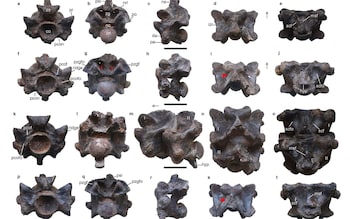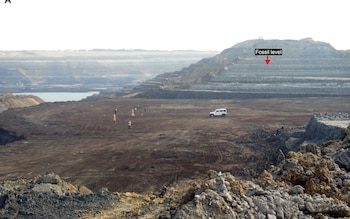 The snake was named Vasuki indicus after the snake king associated with the Hindu deity Shiva. Photo: Vinod Kumar m/Moment RF
The snake was named Vasuki indicus after the snake king associated with the Hindu deity Shiva. Photo: Vinod Kumar m/Moment RF
A giant prehistoric snake that was longer than a Tyrannosaurus rex has been discovered in an Indian mine.
Fossil vertebrae have been proven to represent the remains of one of the largest snakes that ever lived on Earth, a monster estimated to be up to 15 meters (49 feet) long that roamed the swamps of modern-day India some 47 million years ago.
Scientists said Thursday they had extracted 27 vertebrae from the snake. including several still in the same position they would have been in when the reptile was alive.
They said the snake, which they named Vasuki indicus after the snake king associated with the Hindu deity Shiva, looked like a modern large python and was not venomous.
The mine is in the Panandro district of Kutch district in the western Indian state of Gujarat .
«Given its large size, Vasuki was a slow predator that ambushed and subdued its prey through constriction, like anacondas and pythons,» said Debajit Dutta, lead author of the study published in the journal Scientific Reports.
“This snake lived in a swampy swamp near the coast at a time when global temperatures were higher than today.”
 Some vertebrae of Vasuki indicus found in an open-pit coal mine Authors: Sunil Bajpai, Debajit Dutta, Poonam Verma via AP
Some vertebrae of Vasuki indicus found in an open-pit coal mine Authors: Sunil Bajpai, Debajit Dutta, Poonam Verma via AP
Due to Due to the incomplete nature of Vasuki's remains, researchers have estimated a length range of 11-15 meters. and an approximate weight estimate of approximately a ton.
Vasuki rivals in size another huge prehistoric snake called Titanoboa, whose fossils were discovered in a coal mine in northern Colombia, South America, stated to be 20
metric tons, and lived 58-60 million years ago . The reticulated python is the longest living snake, sometimes reaching 20-30 feet (6-9 meters).
“The estimated body length of Vasuki is comparable to that of Titanoboa, although Titanoboa's vertebrae are slightly larger than those of Vasuki. However, as of now, we cannot say whether Vasuki was more massive or slender compared to Titanoboa,” said paleontologist and study co-author Sunil Bajpai, professor at IITR.
These huge snakes lived during the Cenozoic era, which began after the age of dinosaurs ended 66 million years ago.
Perhaps the most famous Tyrannosaurus rex rex is a specimen named Sue from the Field Museum in Chicago, 40.5 feet (12.3 meters) long, although a Tyrannosaurus rex would be more massive than these snakes.
Vasuki's largest vertebra was about 4.5 inches (11.1 cm) wide. Vasuki appears to have had a wide, cylindrical body about 17 inches (44 cm) wide. The skull was not found.
 Panandro Mine in Kutch, Gujarat, India, where the remains were found. Photo: S. Bajpai, D. Dutta, P. Verma
Panandro Mine in Kutch, Gujarat, India, where the remains were found. Photo: S. Bajpai, D. Dutta, P. Verma
“Vasuki was a majestic animal,” Dutta said. “It could well have been a gentle giant resting its head on the high porch created by curling up its massive body most of the day, or moving sluggishly through the swamp like an endless train. In some ways, it reminds me of (fictional giant snake) Kaa from The Jungle Book.
Researchers are not sure what kind of prey Vasuki ate, but given its size, it may have included crocodiles. Other fossils in the area included crocodiles and turtles, as well as fish and two primitive whales, Kutchicetus and Andrewsithius.
Wasuki was a member of the snake family Madtsoiidae, which appeared approximately 90 million years ago but became extinct approximately 12,000 years ago back. According to Bajpai, these snakes spread from India through southern Eurasia and into North Africa after the Indian subcontinent collided with Eurasia about 50 million years ago.
It was the dominant family of snakes during the last stages of the age of dinosaurs and into subsequent years. early in the Cenozoic, before their diversity declined, Bajpai added.
«Snakes are amazing creatures that often amaze us with their size, agility and lethality,» Dutta said.





















































Свежие комментарии